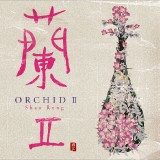|

PMR-0044 |
ORCHID II /
SHAO RONG
01. A Tropical Island |
|
An album that makes you feel the infinite possibilities of the Chinese lute has just been released. The album is by the beautiful Chinese lute player Shao Rong who after releasing her first album "Orchid" in America nationwide received so much attention from the press.
In this, her second album, Shao Rong again shows her mastery of the Chinese lute. "Orchid" is one such masterpiece and provides the title of the album. Its melody, composed by Missa Johnouchi, is reminiscent of Europe. In contrast, "Desert Flowers" has a distinctly West-Asian flavor. There are two pieces with vocals - "Milky Way" and "Dreaming" - in which Shao Rong sings lyrics that she herself wrote. In China, lute players do not sing as they play in the way of the Japanese lute players. This recording is Shao Rong's first attempt at this style of performance and it was a somewhat a hesitant one at first. She admits now that these two pieces have become her most favorite. The soft whispering of the lyrics sound like the tones of bells heard from a far and these very pleasant sounds mix with the almost transparently clear tones of the lute. Shao Rong's style of performance with the tremolo method creates sounds that shimmer like precious gems spilling out from the treasure box. These shimmering notes of the Chinese lute played together with the Western type instruments like violin and piano, performing pieces from the melancholy melody to the up-tempo comprise a repertoire that transforms the conventional image of this instrument. The history of the Chinese lute begins when two types of string instruments were brought into China in the 4th century. One type was brought from India and the other from Iran and they converged with the instrument already existing in China. The Chinese lute and the Japanese lute are originally from the same roots but the Chinese lute kept evolving for the past two thousand years eventually becoming the instrument we see today. Compared to the Japanese lute which has only 6 frets, the Chinese version has 31. The Chinese lute is played with nails made of tortoise shells worn on the five fingers while the Japanese lute is played with a plectrum. The two instruments are completely different in their tones and in the ways that they are played. The Chinese lute has a wider range and richness of tones which gives it the versatility to play different styles of music from both East and West. Please listen to the album and enjoy the many diverse worlds of dreams brought to life by the mesmerizing tones of the Chinese lute. |
